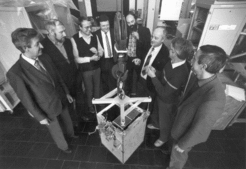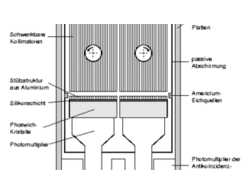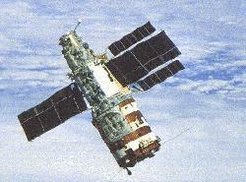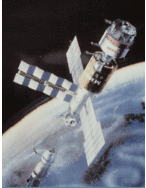MIR - HEXE (1987 - 2001)
The High Energy X-Ray Experiment (HEXE), built by MPE in collaboration with the "Institut für Astronomie und Astrophysik" at the University of Tübingen, Germany (AIT), was one of the four X-ray instruments on board the Kvant module, docked to the Soviet space station Mir since April 1987 (Reppin et al. 1985). Originally HEXE should have been operated on the space station Salyut 7 (see the former logo), but Salyut 7 was replaced by Mir when HEXE was launched. The astrophysics module Kvant 1 was connected to Mir since April 1987 and the four instruments were used until the end of Mir (March 23, 2001), although not very often in the later phase of the mission.
HEXE consisted of four individual phoswich detectors sensitive in the energy range 20-200 keV, providing a total effective area of 750 cm2. 3.2 mm thick NaI(Tl) crystals are backed by 50 mm thick CsI(Tl) scintillators. In addition the whole detector is surrounded by plastic anticoincidence shields. The energy resolution is approximately 30 % (FWHM) at 60 keV. The field of view is defined by two honeycomb tungsten collimators with a triangular response function of 1.6 x 1.6 deg FWHM.
Normal HEXE observations consisted of intervals of data acquisition of about 10-25 minutes, called sessions. The sessions are subdivided into alternating 240 s background and 270 s on-source pointings. The HEXE field of view is changed periodically from a background field - which is several degrees off the source - to the source and back.
Mir-HEXE was the space-proof version of a section of the (Ballon-) HEXE also built and operated in close collaboration with the AIT. It was used to observe the X-ray sky during three successful flights in the years 1980 to 1982.









